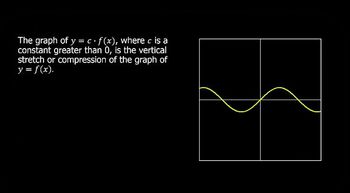Table of contents
- 0. Review of Algebra4h 16m
- 1. Equations & Inequalities3h 18m
- 2. Graphs of Equations43m
- 3. Functions2h 17m
- 4. Polynomial Functions1h 44m
- 5. Rational Functions1h 23m
- 6. Exponential & Logarithmic Functions2h 28m
- 7. Systems of Equations & Matrices4h 6m
- 8. Conic Sections2h 23m
- 9. Sequences, Series, & Induction1h 19m
- 10. Combinatorics & Probability1h 45m
3. Functions
Transformations
Problem 110
Textbook Question
In Exercises 107-118, begin by graphing the cube root function, f(x) = ∛x. Then use transformations of this graph to graph the given function. g(x) = ∛(x-2)
 Verified step by step guidance
Verified step by step guidance1
Start by graphing the basic cube root function, \( f(x) = \sqrt[3]{x} \). This graph passes through the origin (0,0) and is symmetric about the origin, with a gentle S-shape.
Identify the transformation needed to graph \( g(x) = \sqrt[3]{x-2} \). Notice that the expression inside the cube root, \( x-2 \), indicates a horizontal shift.
Understand that \( x-2 \) represents a shift to the right by 2 units. This is because the function \( \sqrt[3]{x} \) is shifted horizontally by the value that makes the expression inside the cube root zero.
Apply the horizontal shift to the graph of \( f(x) = \sqrt[3]{x} \). Move every point on the graph of \( f(x) \) two units to the right to obtain the graph of \( g(x) = \sqrt[3]{x-2} \).
Verify the transformation by checking key points. For example, the point (0,0) on \( f(x) \) becomes (2,0) on \( g(x) \), and the point (1,1) on \( f(x) \) becomes (3,1) on \( g(x) \).
Recommended similar problem, with video answer:
 Verified Solution
Verified SolutionThis video solution was recommended by our tutors as helpful for the problem above
Video duration:
1mPlay a video:
Was this helpful?
Key Concepts
Here are the essential concepts you must grasp in order to answer the question correctly.
Cube Root Function
The cube root function, denoted as f(x) = ∛x, is a fundamental mathematical function that returns the number which, when cubed, gives the input value x. This function is defined for all real numbers and has a characteristic S-shaped curve that passes through the origin (0,0). Understanding its basic shape and properties is essential for graphing and transforming it.
Recommended video:

Imaginary Roots with the Square Root Property
Graph Transformations
Graph transformations involve shifting, stretching, compressing, or reflecting the graph of a function. In this case, the transformation applied to the cube root function f(x) = ∛x to obtain g(x) = ∛(x-2) is a horizontal shift to the right by 2 units. Recognizing how these transformations affect the graph is crucial for accurately sketching the new function.
Recommended video:

Intro to Transformations
Horizontal Shifts
A horizontal shift occurs when a function is modified by adding or subtracting a constant from the input variable. For g(x) = ∛(x-2), the '-2' indicates a shift of the graph of f(x) = ∛x to the right by 2 units. This concept is vital for understanding how the position of the graph changes without altering its shape.
Recommended video:

Shifts of Functions

 5:25m
5:25mWatch next
Master Intro to Transformations with a bite sized video explanation from Nick Kaneko
Start learningRelated Videos
Related Practice
























